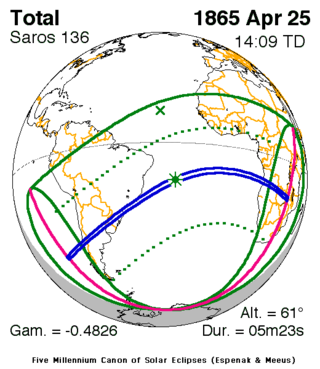A total solar eclipse occurred on April 25, 1865. A solar eclipse occurs when the Moon passes between Earth and the Sun, thereby totally or partly obscuring the image of the Sun for a viewer on Earth. A total solar eclipse occurs when the Moon's apparent diameter is larger than the Sun's, blocking all direct sunlight, turning day into darkness. Totality occurs in a narrow path across Earth's surface, with the partial solar eclipse visible over a surrounding region thousands of kilometres wide.
| Solar eclipse of April 25, 1865 | |
|---|---|
| Type of eclipse | |
| Nature | Total |
| Gamma | −0.4826 |
| Magnitude | 1.0584 |
| Maximum eclipse | |
| Duration | 323 s (5 min 23 s) |
| Coordinates | 14°48′S 25°48′W / 14.8°S 25.8°W |
| Max. width of band | 219 km (136 mi) |
| Times (UTC) | |
| Greatest eclipse | 14:08:34 |
| References | |
| Saros | 136 (29 of 71) |
| Catalog # (SE5000) | 9199 |
Observations
editThe total eclipse was also witnessed by the passengers and crew of the SS Great Britain, passing the coastline of Brazil en route from Australia to England;[1][better source needed] they were able to observe stars in the daytime.
Related eclipses
editSaros 136
editThis eclipse is a part of Saros series 136, repeating every 18 years, 11 days, and containing 71 events. The series started with a partial solar eclipse on June 14, 1360. It contains annular eclipses from September 8, 1504 through November 12, 1594; hybrid eclipses from November 22, 1612 through January 17, 1703; and total eclipses from January 27, 1721 through May 13, 2496. The series ends at member 71 as a partial eclipse on July 30, 2622. Its eclipses are tabulated in three columns; every third eclipse in the same column is one exeligmos apart, so they all cast shadows over approximately the same parts of the Earth.
The longest duration of annularity was produced by member 9 at 32 seconds on September 8, 1504, and the longest duration of totality was produced by member 34 at 7 minutes, 7.74 seconds on June 20, 1955. All eclipses in this series occur at the Moon’s descending node of orbit.[2]
| Series members 26–47 occur between 1801 and 2200: | ||
|---|---|---|
| 26 | 27 | 28 |
| March 24, 1811 |
April 3, 1829 |
April 15, 1847 |
| 29 | 30 | 31 |
| April 25, 1865 |
May 6, 1883 |
May 18, 1901 |
| 32 | 33 | 34 |
| May 29, 1919 |
June 8, 1937 |
June 20, 1955 |
| 35 | 36 | 37 |
| June 30, 1973 |
July 11, 1991 |
July 22, 2009 |
| 38 | 39 | 40 |
| August 2, 2027 |
August 12, 2045 |
August 24, 2063 |
| 41 | 42 | 43 |
| September 3, 2081 |
September 14, 2099 |
September 26, 2117 |
| 44 | 45 | 46 |
| October 7, 2135 |
October 17, 2153 |
October 29, 2171 |
| 47 | ||
| November 8, 2189 | ||
References
edit- ^ "Brunel's SS Great Britain on Instagram: "#OTD in 1865 passengers witnessed a Solar Eclipse. 🌘 "Total eclipse of the sun, a clear sky and stars seen in daytime" - diary extract (author unknown) . . . #SSGreatBritain #SolarEclipse #Museum #Victorian #Brunel #Bristol #History"". Instagram. Retrieved 2023-04-25.
- ^ "NASA - Catalog of Solar Eclipses of Saros 136". eclipse.gsfc.nasa.gov.
- NASA chart graphics
- Googlemap
- NASA Besselian elements
- Mabel Loomis Todd (1900). Total Eclipses of the Sun. Little, Brown.
